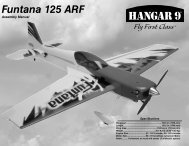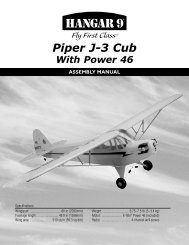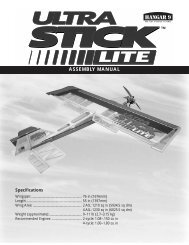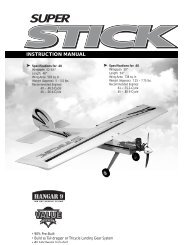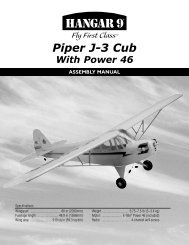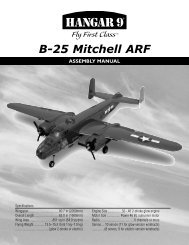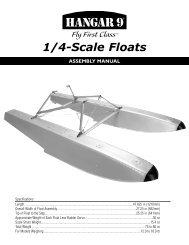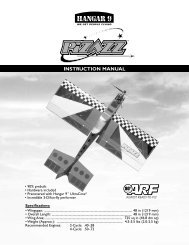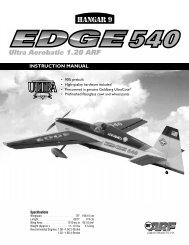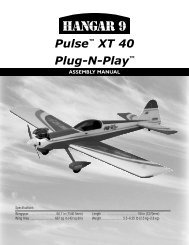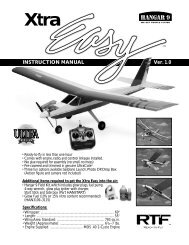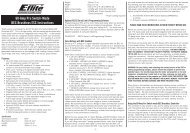Instruction Manual - Horizon Hobby
Instruction Manual - Horizon Hobby
Instruction Manual - Horizon Hobby
You also want an ePaper? Increase the reach of your titles
YUMPU automatically turns print PDFs into web optimized ePapers that Google loves.
Glossary of Terms• Ailerons: Each side of this airplane has a hinged controlsurface (aileron), located on the trailing edge of the wing. Movethe aileron stick on the transmitter left, the left aileron moves upand the right aileron moves down. Moving the left aileron upcauses more drag and less lift, causing the left wing to dropdown. When the right aileron moves down, more lift is created,causing the right wing to rise. This interaction causes theairplane to turn or roll to the left. Perform the opposite actions,and the airplane will roll to the right.• Carburetor: By adjusting the needle valve in the carburetor,you control the engine’s lean/rich fuel mixture and set theengine for correct operation.• Charger: This is the device used to charge/recharge batteries.If Ni-Cd batteries are provided with the radio, a charger isusually provided as well.• Clevis: The clevis connects the wire end of the pushrod to thecontrol horn of the control surface. A small clip, the clevis hasfine threads so that you can adjust the length of the pushrod.• Clunk: Located inside the fuel tank, a clunk is weighted andensures that the intake line has a steady supply of fuel regardlessof the altitude of the airplane.• Control Horn: This arm connects the control surface to theclevis and pushrod.• Control Surfaces: The moveable part of the wing and tail thatcause the aircraft to roll (aileron), pitch (elevator) or yaw (rudder).• Dead Stick: When the airplane is in flight, gliding without theengine running, it is called “dead stick.”• Dihedral: The degree of angle (V-shaped bend) at which thewings intersect the fuselage is called dihedral. More dihedralgives an airplane more aerodynamic stability. Some sailplanesand trainer planes with large dihedral dispense with aileronsand use only the rudder to control the roll and yaw.• Electric Starter: This is the small motor commonly used tostart the airplane’s engine.• Elevator: The hinged control surface on the back of thestabilizer that moves to control the airplane’s pitch axis. Pullingthe transmitter’s control stick toward the bottom of the transmittermoves the elevator upward, and the airplane begins to climb.Push the control stick forward, and the airplane begins to dive.• Expanded Scale Voltmeter (ESV): This device is used tocheck the voltage of the battery pack.• Flight Box: The box in which you store and transport yourflying equipment is called a flight box.• Flight Pack or Airborne Pack: These interchangeable termsdescribe the radio equipment that is installed on the airplane.• Fuel Overflow Line (Vent): This line connects to the mufflerand pressures the fuel tank when the engine is running. It alsofunctions as an overflow line when the fuel tank is full.• Fuel Pickup Line: This line connects the fuel tank tothe carburetor.• Fuselage: The main body of an airplane.• Glow Plug Clip/Battery: A 1.2-volt battery with a clip that isconnected to your engine’s glow plug and is used to start theengine. You remove it once the engine is running smoothly.• High Wing: The term describes an airplane that has its wingmounted on the top of the fuselage.• Hinge: Flexible pieces used to connect the control surface tothe flying surface. All hinges must be glued properly andsecurely to prevent the airplane from crashing. (This has alreadybeen done for you on the Arrow Advanced trainer.)• <strong>Horizon</strong>tal Stabilizer: The horizontal flying surface of the tailgives the airplane stability while in flight.• Leading Edge: The front of a flying surface.• Main Landing Gear: The wheel and gear assembly theairplane uses to land. It is attached to the bottom of the fuselage.• Muffler: This device muffles engine noise and increases theback pressure from the engine’s exhaust stack, which canimprove the engine’s performance at low speeds. RC clubs usuallyrequire mufflers.• Needle Valve: This mechanism within the carburetor adjuststhe fuel mixture. Refer to your instructions fordirections on how to adjust the needle valve.• Ni-Cd: This abbreviation stands for Nickel Cadmium, thechemical compound used in rechargeable batteries.• Nitro: Short for nitromethane, a fuel additive that improvesan engine’s performance. 10% to 15% nitro content isrecommended for the Evolution engine.• Nose Gear: The part of the landing gear that is attached to thenose of the fuselage. The nose gear is usually connected to therudder servo to help you steer the airplane on the ground.• Pitch Axis: The horizontal plane on which the airplane’s noseis raised or lowered. By moving the elevator, you can raise theairplane’s nose above the pitch axis (climb) or lower it below thepitch axis (dive).• Pushrod: The rigid mechanism that transfers movement fromthe servo to the control surface.• Receiver: The receiver unit in an airplane receives signals fromthe ground transmitter and passes the instructions along to theairplane’s servos.14



